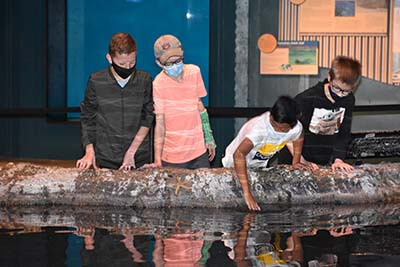October 7, 2021
 from Dr. Bill Hudson, Head of School
from Dr. Bill Hudson, Head of School
On Wednesday, 48 seventh graders excitedly boarded buses for a day at the Minnesota Zoo. From the outside it might look like a typical field trip, but in true MPA fashion, it is a thoughtfully crafted lesson that intentionally weaves together science, student agency, experiential learning, critical thinking, creativity, design thinking, and a dose of joy. There is a lot to unpack in that description, but I’d like to focus on just one aspect, experiential learning.
You have no doubt heard the term, “hands-on, experiential learning” sometime during your time at MPA. We use it often but have rarely explained it and its importance to learning. The concept first appeared in “Nicomachean Ethics” written in 350 BC by Aristotle, “For the things we have to learn before we can do them, we learn by doing them.” Modern educational theorists such as John Dewey wrote about the importance of learning by doing, but it is David Kolb who developed an experiential learning theory and model. It was upon this body of knowledge that MPA developed our founding pedagogy in 1982.
Kolb defined experiential learning as “The process whereby knowledge is created through the transformation of experience.” Experiential learning recognizes that students come to school with past experience and knowledge and that the school’s job is to provide a rich learning environment that engages the students at their individual levels. Examples of experiential learning abound at all grade levels at MPA and include hands-on laboratory experiments, projects in the Makerspace, work in outdoor gardens, monarch butterfly way stations, prairie restoration, field trips, performances, and more.
Kolb believed that experiential learning occurs in four stages: concrete experience, reflective observation, abstract conceptualization, and active experimentation. Teachers begin with student’s prior knowledge and experiences and lead them through a process of reflecting on what they are observing, helping them to notice any gaps or inconsistencies between what they are observing and what they know. They then support students as they modify their prior knowledge or create new ideas. Finally, teachers encourage students to put that new idea or knowledge into practice in a new context.
The seventh grade trip to the Minnesota Zoo is an excellent illustration of experiential leaning in practice. Students are studying biomimicry in their Science and Design course. Biomimicry is a new term for a concept that has been around for a while and means looking toward nature to solve real-world complex problems. According to Jeffrey Karp, a leader of the current biomimicry movement, “Every living creature that exists today is here because it tackled a number of challenges. In essence, we are surrounded by solutions. Evolution is truly the best problem-solver.”
The trip to the Zoo was an experiential learning project designed by John Milam, Middle School science teacher. “We went to the Zoo to refine our observation skills, learn more about particular flora, fauna, and habitats, and to have some fun outside of the classroom,” said Mr. Milam. In preparing for the trip, Mr. Milam gave students two choices:
- Begin with a problem, become really immersed in it (empathize, in the design thinking process), look to nature to see how it has or would solve the problem, invent a solution, and build a prototype.
- Become an expert in something in nature, decide what unique features could be translated to a real-world problem, design a solution, and build a prototype.
In both instances, students are required to create and present their solution as if they are on Shark Tank.
The creativity of our students is astounding. Last year, one student addressed backpacks. Backpacks are too heavy and are harmful to the proper growth of young people. He studied this problem and looked to the camel/kangaroo to see how they solved this problem. He designed and built a boot that carries notebooks, pens, etc. Rather than having the weight riding on the backs of students, the weight was distributed and carried by the legs. Another student studied and became an expert in woodpeckers. The student learned how woodpeckers are able to pound their head into trees and remain unharmed. This “technology” was then used to design and build a fully enclosed helmet that transferred the impact throughout the helmet and not the skull.
Experiential learning is at the heart of what we do at Mounds Park Academy. Being challenged academically isn’t only about memorizing facts and figures, solving equations, and completing assignments. It’s also about being encouraged to think independently and taught to communicate effectively. And it’s about connecting deep content knowledge to real-world problems in ways that allow students to make significant and positive impacts.